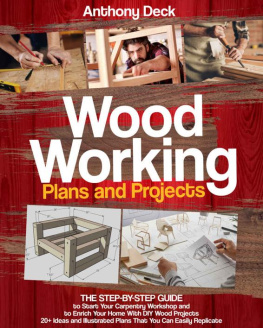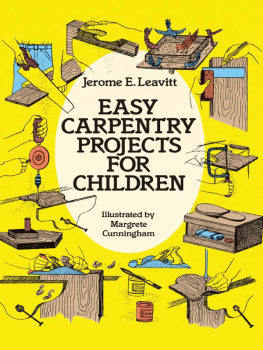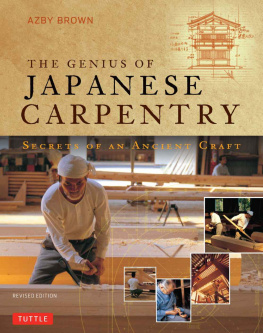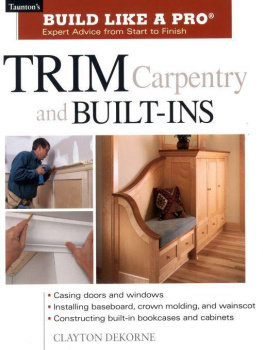
Text by Andy Engel, 2011 by The Taunton Press, Inc.
Photographs 2011 by The Taunton Press, Inc., except as noted.
Illustrations 2011 by The Taunton Press, Inc.
All rights reserved.

The Taunton Press, Inc.,
63 South Main Street, PO Box 5506,
Newtown, CT 06470-5506
e-mail:
Editors: Martin Miller, Alex Giannini
Copy editor: Seth Reichgott
Technical editor: Kevin Ireton
Cover design: Kimberly Adis
The following manufacturers/names appearing in Carpentry Complete are trademarks: Alum-A-Pole, Andersen, Arrow, Bessey, Bosch, Bostich, Campbell Hausfeld, C.H. Hanson, Construction Master, DeWalt, Disston, FatMax, Festool, Grace Construction Products, Ice & Water Shield, Jawhorse, Lie-Nielson, Little Giant, Makita, Milwaukee Electric Tool Corporation, Occidental Leather, Parallam, Paslode, Peltor, Porter-Cable, Protecto Wrap, Qual-Craft, Rockwell, Sawzall, Senco, Shark, Silky, Silly Putty, Simpson Strong-Tie, Speed Square, Stabila, Stanley, Starrett, Stiletto, Swanson, Tajima, Trojan, Trus Joist, Truss Plate Institute, Velux, Werner, Weyerhaeuser, York.
Construction is inherently dangerous. Using hand or power tools improperly or ignoring safety practices can lead to permanent injury or even death. Don't try to perform operations you learn about here (or elsewhere) unless you're certain they are safe for you. If something about an operation doesn't feel right, don't do it. Look for another way. We want you to enjoy working on your home, so please keep safety foremost in your mind whenever you're in the shop.
No book is the work of one person, but rather a sum of knowledge and effort channeled through the author. In thanking people, I have to start with Patricia Steed, my wife and the center of my world. Pat took most of the photos for this book, many while hobbling around construction sites on a broken ankle. My sons Kevin and Duncan also pitched in. I was proud to see them working like men. I don't know how this book would have come to life without Kevin Ireton, who worked alongside me for months out of friendship and on my promise to return the favor. Others who helped include Brent Benner, Chris Green, Brian Rogers, Joe Cichowski, Bill Georgia, Dave Easter, Jim Larrabee, Strother Purdy, Mark Propsner, Mike Guertin, Greg Burnet, Glenn Mathewson, and Rob Arnold. This book would not have seen the light of day without the confidence of Helen Albert and Peter Chapman at The Taunton Press, nor without the layout and editing skills of Marty Miller. If I've forgotten anyone, I apologize. Thank you all.
I owe thanks to more than just the good people mentioned above. I owe them also to those who wrote down their knowledge in the magazines and books that fill my shelves, particularly those early Fine Homebuilding authors whose words were water in the desert to a young carpenter. And I do not forget the carpenters I learned from, veterans of WWII and Korea who are now mostly gone. In building new, we can't help but touch the past.
CONTENTS









Finish Skirtboards, Treads, and Risers
TOOLS AND MATERIALS
YOU CAN'T BE A CARPENTER without tools. Do you need a lot of them? No. The men I learned from began careers framing houses with a tape measure, a square, a chalkline, a plumb bob and a 4 ft. level, a handsaw, a knife, and a hammer. Trimwork added a hand miter box, a coping saw, nail sets, chisels, a brace and bits, two planes, and a couple of screwdrivers. A toolbelt back then was a canvas nail apron that the lumberyards gave away.
You'll find most of those same tools in my kit today, along with circular saws, power miter saws, electric drillsboth corded and cordlessimpact drivers, and a whole range of pneumatic tools that make carpentry more efficient and easier on the carpenter's body.
Carpentry is dangerous. Think about safety consequences. If something feels unsafe, stop and look for another way there is always another way.

HAND TOOLS AND SAFETY
TOOLBELT ESSENTIALS
The toolbelt adds considerably to a carpenter's efficiency by keeping the most frequently used tools and fasteners ready at hand. Inexpensive toolbelts can be fine for the occasional carpenter, although most pros use heavier-duty, better-designed models. A good one should last a decade or moremine is by Occidental Leather.
Don't be lured in by the promise of more and more compartments. Think about the tools you use every day, and be sure they have homes. In this day of nail guns, you might not need the voluminous nail pockets found in a lot of framer-style toolbelts. Consider how many fasteners you're likely to carry with you, and don't plan on carrying more. Bigger toolbelts mean heavier toolbelts, and you'll feel that at the end of the day.
Hammers
Hammers come in a range of sizes, from 16-oz. trim hammers to long-handled 28-oz. framing hammers. Worry less about size than about what feels good in your hand. Today, I drive most nails with compressed air, so I've replaced my specialty hammers with one Stiletto 12-oz. titanium hammer for both framing and trim. It cost a ridiculous amount of money, but I love its balance, and its light weight leaves me a little less tired at the end of the day.
BUY THE BEST TOOLS YOU CAN AFFORD
You don't need them all at once, though. Start out with a good toolbelt and a set of sturdy hand tools, including high-quality levels. If you're framing, get a good circular saw. For trimming, buy a miter saw that's big enough to handle the materials you expect to use. Cordless drills have become a practical necessity, and impact drivers put them to shame for setting screws and lags. Rent tools you use infrequentlyscaffolding, ladders, and wall jacks, for example, and miter saws, circular saws, and nail guns as well.

Toolbelts increase production by keeping your most-used tools ready at hand.

Next page




















